This is a very brief version of the life of Chris Kinman.
Incredible as it may seem, my life is based on a true story.
I was born at a very young age into a family of relatives and that's when all the trouble started. Being a highly strung and highly spirited young bloke some people thought "trouble" was my middle name. Maybe that's because I happen to subscribe to the old philosophy "Life is too important to be taken seriously", that and I was a bit irreverent towards the establishment (with good reason).
Until age 5 we had no town water and no electricity and I had never seen a telephone or a TV set, except in comic books. Mum cooked on a wood fired stove and ironed Dad's overalls with a petrol iron that frequently exploded and scared the daylights out of her. For the first 5 years of school I attended a little 1 room country school that had 8 grades taught by one kindly teacher (Mr Fisher). He couldn't teach 8 grades at the same time so the big kids helped teach the little kids. Mr Fisher picked up some of the kids along his way to the school every morning. His little car looked like a cartoon with kids piled in and hanging out of doors and riding on the running boards and in the open trunk (boot), by some miracle no one ever fell off. Click to see an original 1954 drawing by Mrs Phillys Graham depicting this event. Phyl Graham is the mother of the cute girl next door … more below). But that was way back in the good old days before TV came along and messed everything up. Before that we listened to stories on the Radio and our imaginations created vivid scenes to fit the stories. We didn't have much money but we were happy and my two sisters and myself had a terrific childhood growing up on acreage in a semi rural setting.
I was born curious; when I was 7 I planted a potato in the garden under my bedroom window. I was so curious about how that potato would sprout into a plant I kept digging it up to check it’s progress. The potato plant didn’t like being dug up and eventually died, much to my disappointment. Looking back I can see I was a pretty strange kid after age 7, my bedroom boasted a fine collection of old transformers, vacuum tube radios, electric motors, solenoids, gauges, meters, blowers, gearboxes, wheels, shafts and all kinds of fascinating stuff that Dad had picked up from Military surplus supplies .... but most of it didn't work. We didn't have much money so these things were my toys in my early years and I was always trying to make something that actually worked ... but to no avail. I wanted to impress the cute girl next door with my technical prowess but she was more interested in playing at dressing up. Later on after saving my irregular pocket money for a few years I got the parts to build a Crystal Set radio (no batteries), which really did work. I was so pleased that it actually worked I fell asleep listening to the radio with my old magnetic head-phones on.
Before I reached my teens my Dad impressed upon me the value of inventing something that could be patented. I was so impressed (age 10 mind you) that I lay awake for hours most nights dreaming up inventions, to make money so we could make my stuff work again. In the still of the night I'd get a great idea and yell out excitedly to Dad (who was abruptly and rudely woken from a deep sleep) to tell him of my great idea, sometimes several every night. Yep, I was on fire, churning out ideas by the dozen. Now get this, I was the first one in the world to have the idea of coloured Grass (Red, Orange, Yellow, Blue etc etc lots of different colours). I imagined setting a revolutionary trend with my coloured grass that would create a wild stampede by property owners clamoring to redecorate their gardens and lawns. Yessiree bob, no-one ever beat me to that one. But some of my ideas were a bit more useful and desirable, like an electric safety plug, one that was impossible to accidentally electrocute oneself (or a hapless child) when plugging into the wall..... that was in 1957. I noticed the same invention appearing for the first time on the market in 2004. I also conceived the Jet Boat, using a water pump as a means of propulsion instead of a propeller, that idea surfaced in the mid 1970's in New Zealand, known and the Hamilton Jet and later found in Jet Ski's and more recently in stealthy submarines. But even though I had some good ideas Dad never sought a Patent for any, probably because we didn't have the money to fund a Patent application. And maybe he wanted to avoid the stress and pain in protecting a Patent. As I have learned in some situations the law condones Patent theft by unscrupulous thieving companies, I know that's hard to believe but it's true. He actually held a few patents for the big bad company he worked for. He earned and saved that company millions with his brilliant and innovative engineering, but that company used him up and paid him a pittance. Ian Kinman, my Dad, was a decent man ..... one of those blokes who thought doing a good job was more important than asking for a pay rise, and I guess I subconsciously adopted that philosophy and is probably the reason I struggled for money most of my life. After the big bad heartless company had bled him for years he got sick from stress and in the end that company threw him onto the scrap heap without so much as a penny compensation for giving his life to them. About 18 month later he died at age 42, disillusioned and disappointed. I was 21 at the time.
Anyhow, (jumping back to my childhood) a few years down the track in my early teenage years money was still in short supply and my Dad was working for da big bad company and I didn't see much of him, so I got the blues and became interested in music and guitars and especially pickups. At that time I was trying to follow in Dad's footsteps as an apprentice Fitter and Turner and although I learned to be a high class Manufacturing Engineer, which was an excellent asset in later life as you will soon see, I wasn't happy so I got to playing in a Rhythm & Blues band on weekends. Because I couldn't handle the size of the neck on the Precision Bass, and because apprentices' wages of $10 a week were so low that I couldn't afford a Fender, I decided to manufacture my own electric bass. The pickup was styled after the P-Bass unit and I made it from the ground up including the formed plastic cover. This was many years before after-market pickups like Duncans or DiMarzios were available, and new Fender pickups were only available on an exchange / replacement basis (to prevent people like me from making their own instrument and depriving musical instrument companies of a sale of their own instruments).
In my teenage years I developed a fascination with these mysterious things called pickups. I would get hold of every pickup I could get my hands on and study it closely. I would record all the dimensions, wire gauge and resistance measurements and make notes about the sound it made. I think my motivation in part sprung from the fact that a few people could build guitars OK in those days but practically no one could build a great pickup (except the instrument companies) and I became obsessed with wanting to make a fine sounding pickup. The electrical functions of them were very mysterious and sourcing magnets and wire and fabricating bobbins was something hardly anybody had knowledge about in those days. With my excellent engineering background and a combination of pure arse, luck and relentless pursuit I was able to make a pretty good job of it.
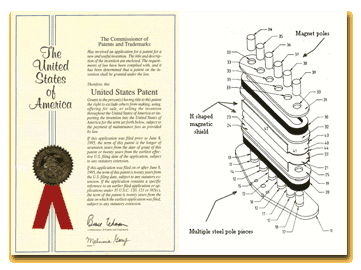
My pride and joy; USA Patent Number; 5,668,520 Applied for March 1996 & issued March 1997. The first of 7.
Later on in my early 20's, after Dad died and Mum had sold the family business I needed something to do so I turned my hobby into a career and I launched a guitar making and guitar repair business from under my rented house and, since there was a distinct lack of skilled guitar technicians in those days, my fledgling business took off. I designed and made my own brand of electric guitars as well as all the hardware and pickups. The only things I sourced outside were the tuners. I used Schallers in those days as Gotoh had not yet come along. I made a pickup-winding machine, partly from various components that I scrounged and partly from bits n pieces I made myself. It wasn't automated but rather hand guided for the layering of the coil. It was gradually refined over and over; changing the design many times until I had it perfected, as far as a hand-guided hands-off-wire machine could be. I made hundreds of my own pickups and performed countless rewinds of Fender, Gibson, Hofner, Guild and various other brand pickups as repairs. Business was good, I was earning $90 a week, well at least I thought that was good after being so chronically short of money all my life.
One day I had a brainwave: an idea for a design for a noise-cancelling Strat pickup that featured 2 phase-opposed vertical coils.
In the early 1970's there were a few customers who asked me if I knew a way to eliminate the hum put out by their Fender pickups, citing the humbucking pickups that Gibsons had. That started me thinking and then it dawned on me that a side-by-side humbucker could be rearranged in a vertical pattern that would fit into a Strat pickup cover, something no-one had thought of at that stage. I thought I was really onto something for a while but then I realized it would sound terrible because of tone destructive phase cancellation and I dropped the whole idea. Years later, other pickup companies discovered the same idea but they put theirs onto the market. These were the stacks, or vertical humbuckers that gained a well-deserved notoriety for really awful sound. I call these tone cancelling pickups. Although I was envious of their success I felt I had done the right thing; I couldn't sell something that I would not use myself. I am a perfectionist with high ideals and that is a very difficult way to be. Everything, even the smallest detail, becomes a major issue and if I am not happy with something I will persist and persist until I get it right, driving myself and everyone around me nuts in the process.
Through the early years I was making mostly Gibson style Humbuckers for the style of guitars I was making then, but I was making improvements to them in response to complaints I got from some of my customers. Those years proved very tough but also very fruitful as I gained a lot of esoteric knowledge about guitars and pickups that wasn't available from any other source (there weren't any books or teachers at that time and I had to learn by myself). Looking back, I can see that what I thought I knew then, was only a drop in the bucket compared to what I was going to learn in the 1980's from my active noise cancelling systems that I designed for Stratocasters*. This was the project that provided me with the knowledge and experience that eventually led me to my current range of Hx pickups. And what I learned then was only a drop in the bucket to what I was going to learn from making my Hx series Zero-Hum pickups.
In the early 1980's I began work on a solid body guitar project I called the Blueprint Series; so called because of my burning desire to make an electric guitar that was based on the great early 50's & 60's Stratocasters. I wanted to solve all the problems with tuning, noise and incorporate handcrafted master luthier workmanship. The only way I could do this was to make the entire guitar from the ground up. I didn't buy in ready-made necks and bodies but made the whole thing from raw wood and other materials. Here's a pic of a few of the guitars I made during the early 1980's.
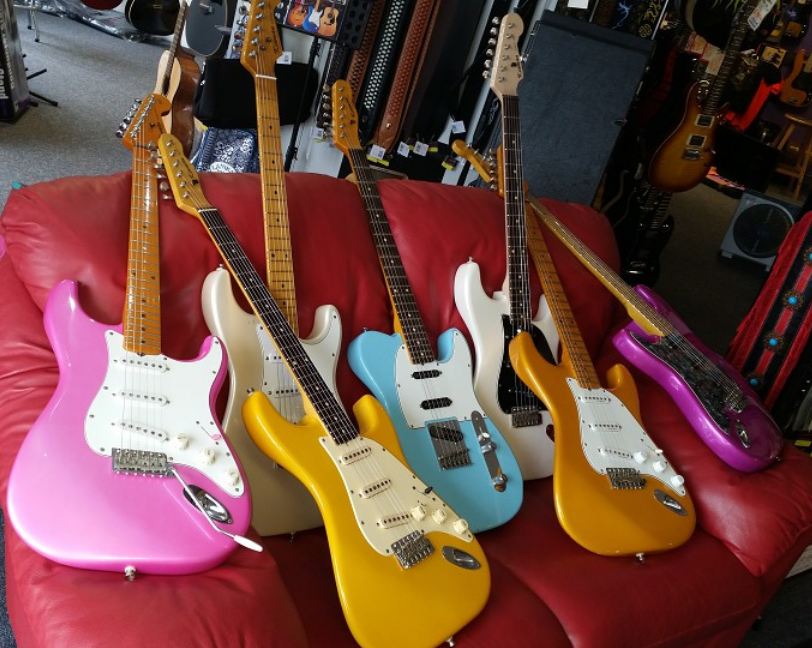
A brace of Kinman hand crafted guitars from the 1980's.
I'm proud to say that these guitars achieved legendary status in a very short time because their tone was truly magnificent, they felt great, they actually worked very well, and they were very dependable; real workhorses. I improved the pitch centering performance of the Vibrato Bridge by making nuts from low friction Teflon and modifying the bridge block itself. I designed my own low-string-pull single-coil pickups, which complemented my guitars perfectly and also became very popular in Australia as after market accessories.
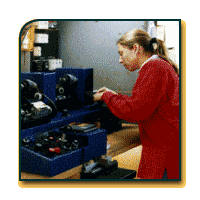
Lisa winds great coils on the NC Kinman winder.
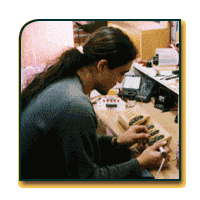
Tim does neat assembly and soldering work.
Just two of the happy family of workers here at
Kinman Guitar Electrix.
At that time I figured the best way to get rid of the hum of single-coil pickups was an active system using phantom (dummy) coils to cancel noise electronically. I designed such a system, the centre piece was a differential Op-Amp and I called it the Kinman Buzzbucker and it worked pretty well. I fitted it as standard equipment to over 130 of my Blueprint Series guitars which were the first and only traditional 'S' class guitar to feature silent pickup operation. Guitar players loved them so much they often bought 2 or 3. I also retrofitted the Buzzbucker to customers' Fenders when they had noise problems but refused to use stacked pickups. However, there were still some problems that I had to overcome in getting my system to work with high impedance guitar pickups such as those on a Strat.
If you always do what you always did you'll always get what you always got.
that's Einsteain's way of saying 'if you sit still you'll never get anywhere' so by 1992 I had re-designed the Buzzbucker 4 times and in my quest for perfection I came up with a revolutionary new system I called the Kinman Humbuster. It was fundamentally different but there were still problems that I just couldn't get around: like having batteries on board, the objectionable impact of active circuitry on tone, and the high cost and labor-intensive installation of the system.
I then had another brainwave: an idea for a passive system without a battery. I built one that was pretty good; it too was less than perfect, but it spurred me onto the road to perfection.
The big turning point:
One day in late 1995 I was in an electronics hobby shop and I spied an inductance meter in the display cabinet. It was the first time I had seen one in a store and I became fascinated with the idea of discovering what inductance various pickups had coz I had seen it written in books about Fender pickups. It was $130 so there was no way I could afford it (still pretty much short of money) so I left the shop feeling frustrated. Driving back to my humble factory I couldn't get that thing out of my mind. Surprising myself with a sudden impulsive U-turn I headed back to brashly fork out the money and buy that Inductance meter. Driving back to the factory I was feeling pretty excited but then the guilt trip started. I heard my Dad's voice from the other side saying "You idiot, you just spent a whole weeks pay on a toy ... what the hell are you thinking? You just gonna play with that thing and it'll be a complete waste of money. You have kids to feed and clothe and sent to school, you are completely irresponsible". Ohh sheezzzz I felt so guilty ... so I got to thinking I would take it home for the day and return it for refund the next day, after I played with it and measured a few pickups. Back at the factory I quickly got all the old pickups I had lying around and began measuring their inductance. Strat pickups were 2.3 Henrys. 2.5 Henrys, 2.1 Henrys and so on. I started to get the feel of what inductance did to the sound of pickups. And then a BIG surprise ... I measured a Duncan Stack ... and holy Mackerel ... it measured like 1.8 Henrys or something pathetically low. That came as a big surprise coz that stack had a really high resistance, like 12K or something. I had just uncovered the awful truth about Stacked pickups, the reason they sounded so bad. I immediately grasped what caused the significant low inductance reading, it was magnetic coupling between the coils. I had scientifically confirmed what I suspected way back in 1970 when I scrapped that very flawed concept 24 years before. But now I could see the awful sound expressed as an electrical measurement, thanks to that inductance meter. Even though I stayed at the factory until near midnight that day I never did take it back for a refund, and I hope Dad eventually forgave me from the great beyond for recklessly spending so much money on a 'toy' because that meter was about to shape the rest of my adventurous life.
Now with science as a tool and a guide to design I kept on experimenting with ideas of how to prevent loss of inductance by magnetic coupling and soon I had the scent of a single unit pickup that looked just like a traditional Strat pickup, used Alnico rod magnets, was passive and yet had no 60Hz hum. I considered this the ultimate goal and I understood the value of such a design not only in monetary terms but also personal satisfaction and it was personal satisfaction that drove me for most of my working life.
Using that inductance meter I made many important discoveries which led to many different experimental designs and various different magnets and pole piece configurations, various coil designs .... but all had real problems with magnetic coupling, just like conventional stacks have. That meter taught me just what a slippery customer magnetism is for I discovered lots of weird magnetic behaviors, ones that I could never have anticipated and which defy conventional logic.
After 4 months and much research and experimenting I achieved a breakthrough in design which was so astounding that I eventually filed for an American Patent, after agonizing for ages about the cost of doing so. At one point I got cold feet and decided not to proceed and then a friend reinforced it to me in quite a strong manner that I had been given a rare opportunity to make a difference, not only to my life but to the lives of countless guitar players around the world who were afflicted by the mains hum blight. That sobering thought spurred me on and I borrowed the money from my dear old mother to apply for a Patent.
The problem with conventional stacks and sidewinders is that they cancel tone and output voltage right along with the noise. Other pickup makers tried to counter this by winding on many more turns of wire and in so doing they ruined the tone twice over. Stacks invariably measure well in excess of the traditional 6K ohms of a Strat pickup. I had invented a system using two different but compatible technologies that reduced undesirable magnetic coupling effect to negligible proportions. My AVn-'62 vintage pickups actually measure spot on 6K Ohms and 2.46 Henrys of inductance which is quite an achievement even if I do say so myself. There are some pickups around that claim to rival mine but compare these to my Impersonator A56 and see whose sounds better. I know which one you will pick, and it's not theirs.
My first US Patent was granted in March 1997 and my 3rd in August 2000. These are the first Patents issued to anyone for what became the next generation of Zero-Hum single pole pickups using Alnico rod magnets. As of June 1998 there were no other Patents granted in this field. You don't have to be Einstein to figure out that I was the first to accomplish this kind of performance, after all, I had been at it for 16 plus years and that length of experience counts for a lot.
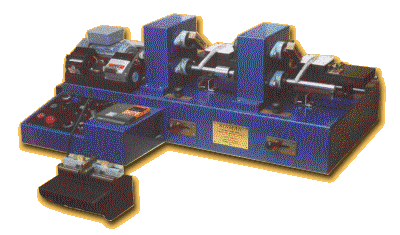
My second pride and joy; the dual chuck, N/C automatic coil winding machine that I designed and built myself in 1994.
In the late 1990's my humble antiquated factory in mid Eastern Australia had been completely reorganized and we no longer made guitars or did high-class repairs (that's too much brain damage). Instead I concentrated on producing my range of great sounding, Zero-Hum, single pole, Strat and Tele class pickups (even more brain damage ahahhHhaa). I have recently, for the first time in my life, earned enough money to pay my bills on time without having to have a bank overdraft. The automatic, numerical control coil winding machine that I designed and built myself in 1994 (see photo beside) was not able to keep up with orders that pour in from all over the world so eventually I lashed out and purchased a second machine that I modified to do the same job as my original one. I am kept busy with my passion of ongoing R.E.D. (research, experimentation and development, formerly called R&D) both in the design of pickups and the design and manufacture of the equipment and machinery that is used in making my pickups. I am very proud of our manufacturing tolerances, which could only be achieved with the advanced new manufacturing technology that I pioneered. For example; the inductance range of my coils varies only3% from specification; this is unheard of in this industry, 10% is more usual. Hand winding is not appropriate for this new pickup design since the Hx design requires precise manufacturing techniques to keep the quality of tone and degree of hum cancellation up to my expectations. This can only be achieved with the use of precision machinery and reliable equipment that is designed to do just one thing ...... make great sounding pickups. I design and make most of the special purpose machinery and equipment found in my factory, it's not like "I can buy this kind of stuff down at the local machinery store". My special coil winding equipment actually simulates and improved upon the best things about hand winding but gives the consistent quality of an computer controlled machine, the best of both worlds, no less.
I guaranteed all my pickups to be consistent in their performance of tone and noise cancellation, otherwise I will replace them for free.
To date I have not been called upon to do that but the door is always open for criticism and suggestions. Such is the faith I have in my AVn 'Greenback' series.
The AVn Greenbacks (as they are known around here because of the striking green baseplate) represent many years of well researched and well developed technological innovation, many long hours over many years have gone into this design. It just didn't happen overnight and I didn't borrow any ideas from anywhere else, they are all original and all mine. The evolution of this product was slow and meticulous and done to my usual high pain-in-the-arse standards. I wanted to be the best in the world, the only single pole Strat and Tele class pickup worthy of the name AVn (Authentic Vintage noiseless).
I believe I have achieved that and so do a lot of others. Gary Moore, Hank Marvin, Bonnie Raitt, Anthony Drennan (The Coors), Jackson Browne, Michael Thompson, John Farrar plus many more lesser known guitar players all over the world who have a yearning for high quality and high performance, who simply want the freedom to enjoy great tone and feel, without the noise that ordinary pickups put out.
Customer: John Huldt / Los Angeles

Chris Kinman.